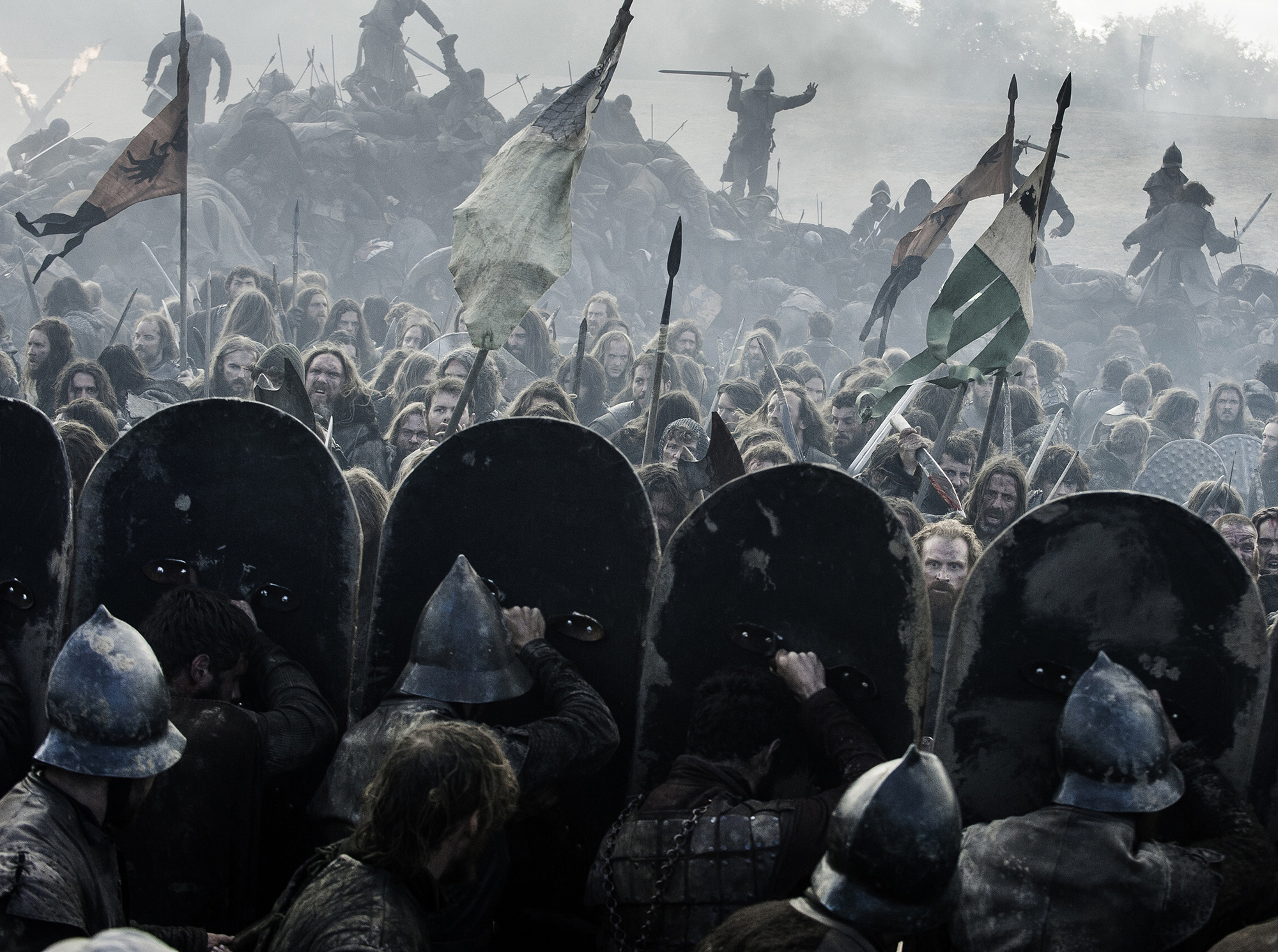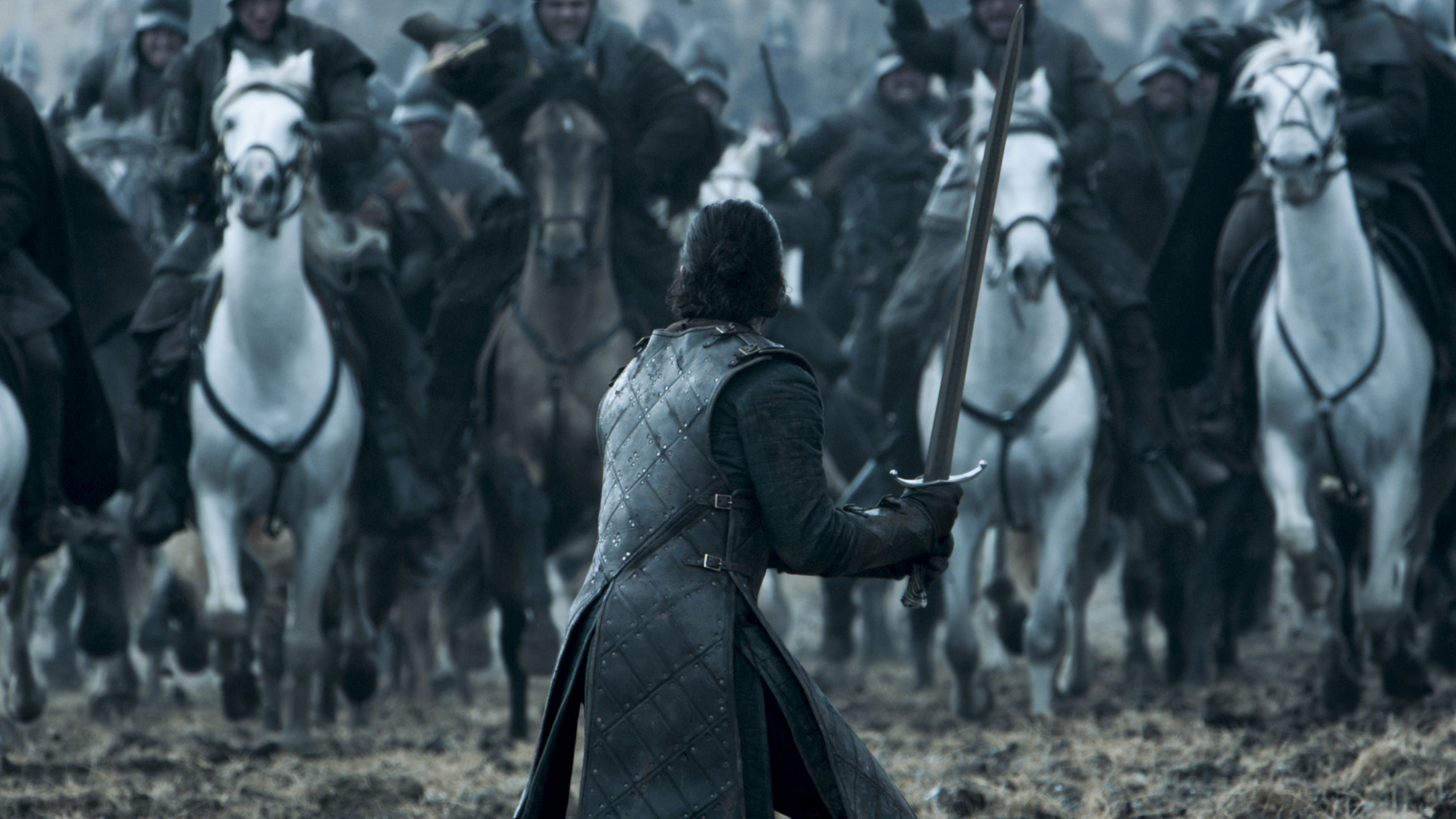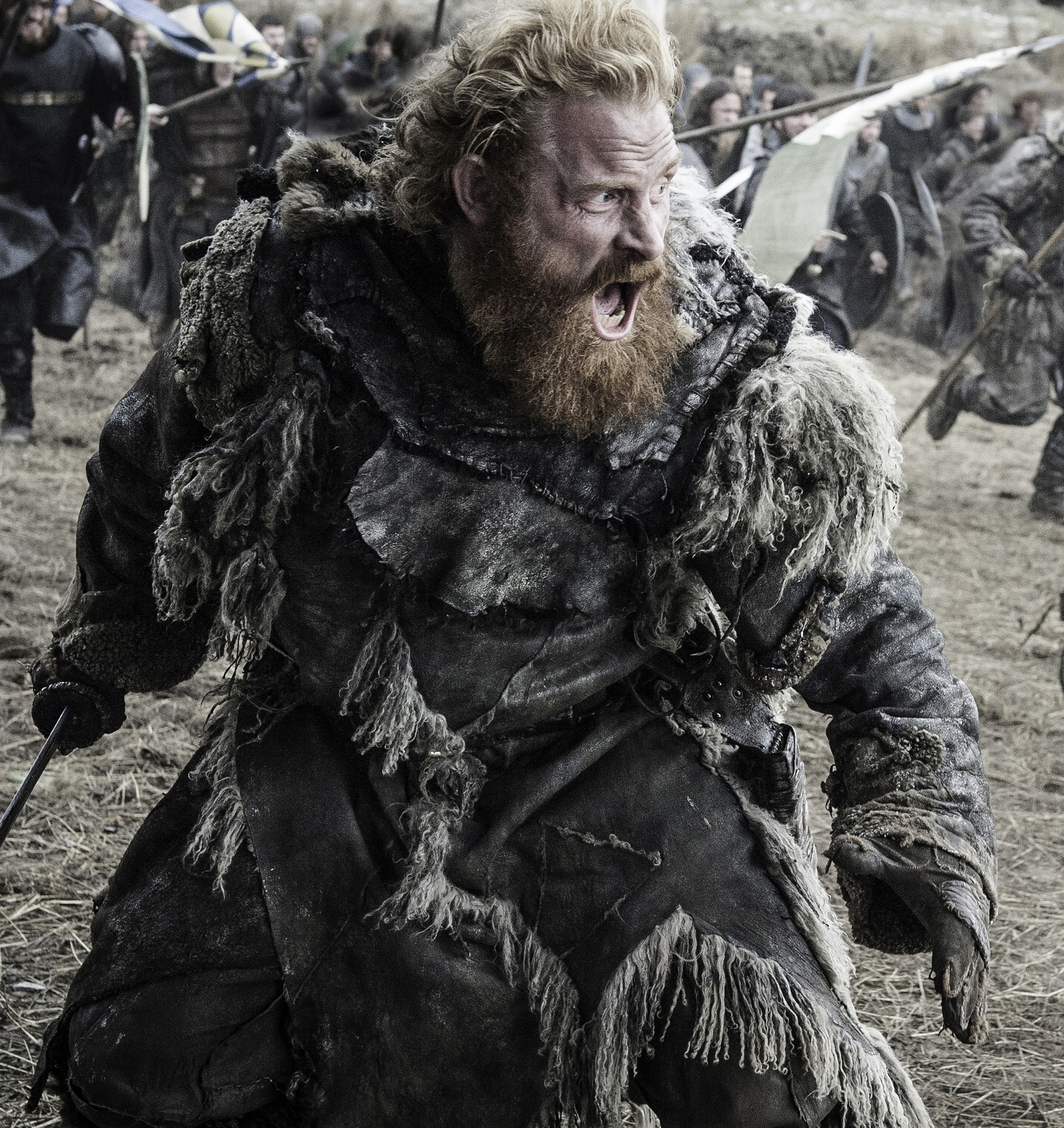When “Battle of the Bastards” aired on June 19, 2016, it represented a new high point for one of TV’s most relentlessly spectacular series.
As Game of Thrones neared the end of its sixth season, the episode brought the year’s drama to a conclusive end, with a revived Jon Snow (Kit Harington) justifying his having been brought back to life by, at long last, putting an end to the malicious Ramsay (Iwan Rheon). This rivalry between one of the show’s most heroic figures and one of its most dastardly set off sparks even before the pair’s armies on horseback got involved.
The episode won Emmys for its writing (a testament to showrunners David Benioff and D.B. Weiss) and its directing (a testament to director Miguel Sapochnik). Writing about the episode immediately after it aired in 2016, I noted that “Battle of the Bastards” “took its place among some of the show’s very best episodes.” The methodical manner in which it was shot, too, speaks to the ways in which Game of Thrones finds its way to greatness — through rigorous work and a wealth of character history. While reporting TIME’s cover story on Game of Thrones, whose new season premieres July 16, I took time to look back on the episode’s grand spectacle. Here are the reflections of a few of the artists and technicians who pitted against one another two bastards, their vast armies and (most powerful of all) their divergent attitudes to power and to revenge.
Director Miguel Sapochnik, previously known for the season 5 blockbuster episode “Hardhome” (a similarly massive, chaotic battle), was chosen for the episode.
Sapochnik (via email): I think the producers often assign episodes appropriate to the skill set of the director but there’s also a lot of changing around and losing people and switching out so there’s reasonable element of chance involved. I only got “Hardhome” because another director had to drop out. Six months is long time to take away from your family and life so that figures into the decision for many directors. The second year I did Thrones, I think I got [“Bastards”] because of “Hardhome.”
The main thing I cared about when we started [“Bastards”] was to avoid trying to simply better “Hardhome.” I didn’t want to approach it that way. I guess I also didn’t want to try to make it different for the sake of distinguishing it. That was one of my main trepidations. Why am I making that choice instead of this one? Is it because it’s what the story calls for or am I trying to be different, or to better myself?
Before anything was shot, the episode was assiduously planned, with costumes and weapons fit for the massive armies.
Tommy Dunne, weapons master: We made 200 shields — they were 6 foot 6. Because “Battle of the Bastards” was so big, we had a phalanx and the spears were 16 feet long with weighted tips so it would feel like the army was impenetrable. We made 250 because we knew we’d have breakages. It took a lot of manpower and a lot of woman-power!

The episode’s dazzling visuals were bolstered by visual effects supervisors Steve Kullback and Joe Bauer, who came up with a pre-visualization of the action relying on an aerial model of the location.
Bauer: We had witness cameras in four spots including overhead looking down. To show the vendor where the channels were so we could put in the CG work.
Kullback: The basic elements were the field, which was enhanced in all directions for having Iceland in the background for the north. The armies were the Starks on one side and the Boltons on the other, and both were largely played by the same group of about 250-odd extras. There were 60 to 80 horses that played on both sides. So you have a battlefield that’s as in-camera as it can be and then you fill that out with CG.
The horses were very real — brought to set by horse mistress Camilla Naprous and trained to carry out all aspects of their roles, including falling to the ground.
Naprous: If we have over 30 to 40 horses, we stable everything on the location, so we cut down on the horses’ time that they work. They have the hotel on-sight, which helps on their rest times, so when they shoot they just go right back to bed. Otherwise they have to travel and it’s not fair on them. So it’s much easier having everything based on the location itself. We had a whole horse village-slash-camp at “Battle of the Bastards” for two months.
We have a bunch of stables, and then we have big marquees, because we have the pack that they wear, all their dressings, their costumes need to be housed. We had 60 grooms looking after it making sure the horses are all taken care of.
Seven fell over at the same time. They’re all trained to fall. I have [about] ten horses whose specific job is to come out and fall over. They’re veterans of the movie industry. One of them, I think he’s fallen over about ten episodes now. He keeps on reappearing!

The shoot was fairly demanding for cast and crew, but some of its demands helped fuel the episode’s particular intensity.
Bauer: 1: It’s a 20-day shoot schedule, standing in that field every day and hoping it doesn’t rain and walking through the mud when it does.
Sapochnik: The shoot was great. Everybody was pretty amped up and ready to go. Having already made “Hardhome” helped because there was lot of trust and confidence going in. The mood was pretty good but everyone also gets tired and you have to keep it light especially when what you are doing is quite dark. The extras were phenomenal. The cast was always there and the crew just kept going, through rain or shine.
Kristofer Hivju, actor (Tormund Giantsbane): I’ve studied how the Vikings fought. And you have the term “berserk.” The Free Folk are not the Vikings, but there are similarities there. I have always used that berserk mode as the main thing — he’s going to be a force. It’s going to be a lot of screaming, and a lot of yelling, and a lot of slit throats. We knew we had a four-week shoot and we knew that we would start off sitting on a horse talking to Ramsay and end up in the mud. I knew it was a lot of running and fighting, so I prepared to be as fit as possible. I have one of the heaviest costumes, and you add the armor, so I need to be as fit as possible every season. When we talked to Miguel before we started, he said we were trying to do something extraordinary. I knew the producers and creators had gone through all the battle sequences in the history of cinema in order to say how can we do it better.
For me, I had my gang of wildlings with me, and they did some really hard work. The thing is, when you’re going to portray chaos, you can’t fake it. When you’re lying in the mud, fighting, and you have 200 people in the mud around you, being pushed from all sides, it’s not safe. But that was what had to be done. I had stuntmen around me, but in a sequence like that, you have to just throw yourself into it, and go berserk, and have ten percent of your brain calculating what’s right to do.

Rowley Irlam (stunt coordinator): I’ve done lots of horse battles on film over the years. Often what happens is the first unit will shoot all the dialogue and all the preamble and it tends to go on and on and on, and the action will get short-changed a little. You film the elements of the battle as opposed to the story of the battle. With “Battle of the Bastards,” we set up a regimented program of what we were going to shoot when. We spent five days doing the parley and the preamble, and fifteen days shooting the action of the battle, the story of the battle and we spent a further five days doing the Winterfell section. So we allocated fifteen stunt days to do the action and we stuck to it. The whole premise of that was trying to find a way to get the audience in the battle. They weren’t watching from the sidelines, they were in it.
I choreographed real action — real horse falls, real saddle-falls — and we left spaces in that to insert CG horse elements. Things that would kill people or horses if we tried to do them for real. The guy he knocks off his horse at the end of section one is a real guy on a wire who was there the whole time and came out of the mist and Kit [Harington] knocked him off his horse. Real Kit, real rider — but you will find that there’s a couple of elements of CG where a horse goes nose-in. It’s about half-and-half. You’ll see a real horse fall, and then in the background of that there’s a CG horse going nose into the mud. You can’t tell what’s real and what’s not real. We are always trying to suspend belief. If they had been all CG, you’d see it. But by mixing and matching, the audience never knows.
“Battle of the Bastards” was the first sequence that I’m aware of that the real stunt action and VFX horse stunt action were from the very beginning. The results speak for themselves.
The episode’s grand-scale brutality gave way to minor-key moments, too, as when Sansa Stark finally got the opportunity to kill episode antagonist Ramsay Bolton, who’d been tormenting her. (After the battle is won, she feeds him to his baying hounds.) For all the machismo madness of the battle against Bolton, it was a girl who once wanted to be a princess who got to deliver the death blow.
Sophie Turner, actor (Sansa Stark): For me as Sophie, it was the most awesome scene, because I’ve been waiting for so long to have my first kill. To constantly see people like Maisie killing people onscreen, and it’s so badass and she looks so cool, and I’m just kind of like dancing around, crying. It felt really good to give Sansa back that power that’s been stripped from her. She’s been manipulating people, but very under-the-radar. She’s still suffering through it. So this was the moment where she had all of the power. I’m sure it was intoxicating for her, too, that feeling she’d been craving for so long, and it was intoxicating for me. I loved it! I want more kills!
The episode’s combination of ambitious visuals, committed acting, and sharp, potent deployment of the series’s core themes made it a favorite among fans and an ideal table-setter for much of what’s to come, with Jon and Sansa reunited at last. Its power relied not solely on spectacle but on its use of spectacle to build on what came before — Jon’s sense of perpetually thwarted duty, arrival of long-delayed justice for Ramsay — and build toward whatever’s next.
Sapochnik: From a macro perspective, Thrones is a bit of a freak of television that I doubt will come along again in a hurry and one could argue it shouldn’t really exist but for some reason it does. This is not due to any one person but a combination of the show’s producers and HBO. Although it’s still a TV show, it operates in the same arena as a massive movie franchise but with one big difference: the almost autonomous creative control of two people, David [Benioff] and Dan [Weiss]. They have evolved a brand of storytelling that is both profound and pulpy at the same time. And they get to really tell the story they want to tell. As a director on the show, my most important goal is to get out of the way and serve the story. So that’s what I try to do.
David and Dan empower those who understand the show and want to make it better. They have surrounded themselves with people who have themselves become experts of sorts on the show’s vast mythology and style. And they know when to intervene and when to let the crew just get on with it. It’s a very demanding but ultimately creative environment. I’d say more often than not the least experienced group are the directors which is why they tend to bring back those who have already run the gauntlet again and again. We don’t get much room to mess up, but we do get the support to run with the ball.
More Must-Reads from TIME
- Caitlin Clark Is TIME's 2024 Athlete of the Year
- Where Trump 2.0 Will Differ From 1.0
- Is Intermittent Fasting Good or Bad for You?
- The 100 Must-Read Books of 2024
- Column: If Optimism Feels Ridiculous Now, Try Hope
- The Future of Climate Action Is Trade Policy
- FX’s Say Nothing Is the Must-Watch Political Thriller of 2024
- Merle Bombardieri Is Helping People Make the Baby Decision
Contact us at letters@time.com